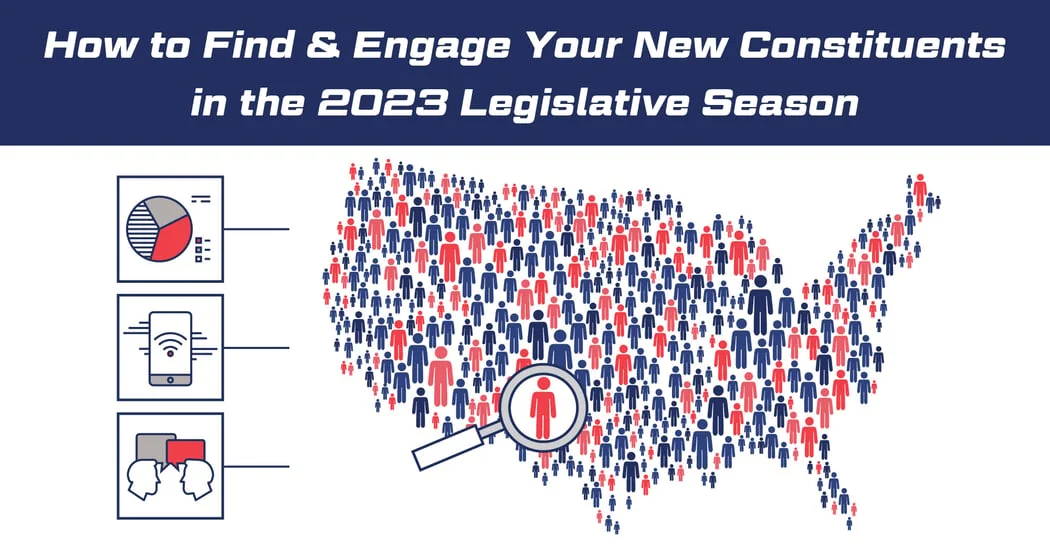
With new districts drawn across the country, and as Congress and state sessions start ramping up, legislative offices must shift into high gear to learn their new constituency and how to engage and effectively communicate with them.
Here we go over the tips and best practices that can set you up for success in this new legislative season.
Find Out Who Your New Constituents Are
For legislators, there’s often no easy way to quickly learn who your new group of constituents is and obtain their contact details. Without a constituent relationship management (CRM) tool that provides this information automatically, leaders often rely on in-person town hall meetings — where only a handful of people is considered a good turnout — in hopes of engaging and connecting with their new constituents.
Rather than counting on in-person engagements or manually trying to get contact lists, a strong CRM tool helps offices connect with a new constituency and stay on top of changes. With this type of tool, your database of contacts is updated the moment your new constituency takes effect, so your communications will always get to the right inboxes.
Your former constituents will remain in the database but marked as out of district; these can be archived or remain in your database. Fireside and Fireside State make it a smooth transition, and you can rely on a CRM that has been through multiple redistricting years and has the experience to overcome all the tedious challenges of updating data and finding new constituents.
Building Relationships and Trust With Your Constituents
Once you have the contact information for your new constituents, it’s vital to have a plan in place to get to know them and the issues that matter to them. Here are three ways to do that:
1. Nail Newsletter Communication
If you don’t already have a regular newsletter for interested constituents, this is a prime opportunity to start one. A weekly newsletter that constituents can opt-in to receive is ideal, but if you’re just getting started with an outbound communications strategy, consider starting with a monthly newsletter.
Your newsletter can include an update on what’s going on in your district, a poll of constituents’ legislative priorities, or an end-of-session report. A newsletter is also an opportunity to follow up on important key votes — for example, share that legislation you supported has passed and how it may impact citizens.
If you already have a regular newsletter cadence, make sure to update your lists so you also reach your new constituents. In addition to looping in these new people to your regular communications, it’s a good idea to send an introductory email only to new constituents letting them know who you are and about the work you’re doing, your legislative priorities, and how they can contact you.
2. Host a Virtual Town Hall
A virtual town hall is a great way to meet new constituents and let them know who you are without the obstacles of asking them to attend an in-person event. This town hall can include your current constituents as well as new ones, since many old constituents may be eager to learn about what your priorities are.
It is a good idea to promote the event publicly via email, at in-person events, SMS broadcasts, robocalls announcing the event, on social media, or through local media. Using multiple channels to broadcast your event can ensure the best possible turnout.
3. Send a Text
SMS, or text messaging, is a surefire way to get a lot of eyeballs and catch the attention of your new constituents. While open rates for an email may be in the 20 percent range, text message open rates jump to the mid-90 percent range, says Scott Crosby, former chief of staff for a Missouri state senator, and now managing director at FiscalNote.
When you have a particularly important or timely message for constituents, sending it via text is an effective way to get high engagement and action rates. You can also include a short video or photo in your message to add a more personal and engaging touch as you introduce yourself.
Get the Latest Constituent Data with Fireside
Many lawmakers and their staff are ill-served by technology to stay on top of constituent communications after redistricting and meeting expanding casework needs. Legislative offices continue to be challenged by budget, time, and staff constraints, and struggle to leverage the opportunity of a new session.
With no comparable all-in-one, fully integrated constituent management platform in the marketplace, Fireside provides an intuitive interface that centralizes, streamlines, tracks, and manages all inbound and outbound communications and casework. During a busy redistricting year, Fireside ensures all your new constituents are immediately added to your database so they don’t miss a single communication.
On a single, easily navigable web-based platform, Fireside provides comprehensive CRM (including casework templates, reminders, and form letters), full inbound/outbound mail management, newsletter outreach tools, phone and video connectivity for live engagements, constituent information and validation, and much more.
